Samsung Teases 512 GB DDR5-7200 Modules
by Dr. Ian Cutress on August 22, 2021 1:02 PM EST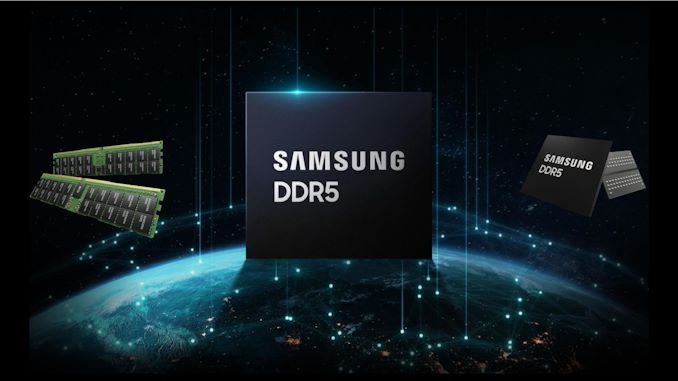
This week as part of the annual Hot Chips semiconductor conference, Samsung’s memory division has presented a poster/slides on a project it is currently working on with impressive end-point results. The company details a 512 GB module of DDR5 memory, running at DDR5-7200, designed for server and enterprise use. This is a step up from the 256 GB modules at the top end of the market today, but to get there, Samsung has been introducing some new features and functionality.
As per standard DDR5 specifications, the modules will run at 1.1 volts with standard JEDEC DDR5-7200 timings, however even JEDEC has not declared an official DDR5-7200 standard at this stage, choosing only to go to DDR5-6400. There are placeholders for future standards, such as DDR5-7200, and based on how the latencies increase from slower speed to higher speed, these should be in the realm of 50-50-50 to 60-60-60*.
*There are three variants for each DDR5 standard – A, B, or C.
DDR5-6400A is 46-46-46 for example, but
DDR5-6400C is 56-56-56.
As part of the presentation, Samsung states that the introduction of Same-Bank refresh (SBR) into its DDR5 will increase the efficiency of the DRAM bus connectivity by almost 10%, with DDR4-4800 showing the best efficiency in terms of energy from bit.
In order to support the higher memory transfer rates of DDR5, Samsung has introduced a new DFE (Decision Feedback Equalizer) for better signal stability. It allows for a more variable data-path location, as well as per-pin calibration techniques.
One of the big things about increasing capacity in memory is that you end up stacking more memory together. For their part, Samsung is stating that they can stack 8 DDR5 dies together and still be smaller than 4 dies of DDR4. This is achieved by thinning each die, but also new through-silicon-via connection topographies that allow for a reduced gap between dies of up to 40%. This is partnered by new cooling technologies between dies to assist with thermal performance.
On power, we’ve known that one of the drivers for JEDEC’s newest memory specifications is lower power, and for DDR5 the major thing aside from the lower voltage is to bring the voltage regulator from the motherboard on to the memory module. This allows for the memory module manufacturer to more tightly control the power requirements and consumption of the memory, especially should the motherboard be a very cheap model that might skimp on valued components at the voltage regulation level. For this 512 GB module, Samsung is using a high-efficiency Power Management IC (PMIC) – Samsung as a company has a lot of PMIC experience through its other electronic divisions, so no doubt they can get high efficiency here. Samsung also states that its PMIC has reduced noise, allowing for lower voltage operation, and also uses a High-K Metal Gate process (introduced on CPUs at 45nm) in a first for DRAM.
One of the talking points on DDR5 has been the on-die ECC (ODECC) functionality, built in to DDR5 to help improve yields of memory by initiating a per-die ECC topology. The confusion lies in that this is not a true ECC enablement on a DDR5 module, which still requires extra physical memory and a protected bus. But on the topic of ODECC, Samsung is showcasing an improvement on its bit-error rate of 10-6, or a factor of a million lower BER. How much of this is required by the DDR5 JEDEC specification is unclear at this point, but it’s still a good direction to have.
At the end of the slide deck from Samsung, it states that its first 512 GB module should be ready for mass production by the end of 2021 – it’s unclear if this is a DDR5-7200 module or something else, as the slide could be interpreted differently. But one of the key aspects to this discussion is when the market expects the crossover of DDR4 and DDR5 to occur: Samsung has a big window of 2023-2024 planned for that crossover, which does align with other market analyst predictions.
This stuff is still going to cost some serious money, which makes me wonder what this means for consumers. Right now the supply of 32 GB modules (UDIMMs) seems to be plentiful for those that want 128 GB of memory in a consumer system. The advent of these new memory packages from Samsung might suggest a path to 64 GB modules for DDR5 on the consumer platform, however you can bet your bottom dollar that they’ll stay for enterprise for a while as they will command a price premium.
Stay tuned for AnandTech’s Hot Chips content throughout this week.


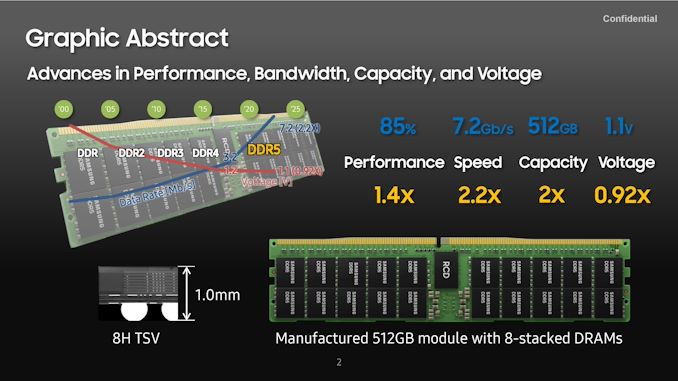
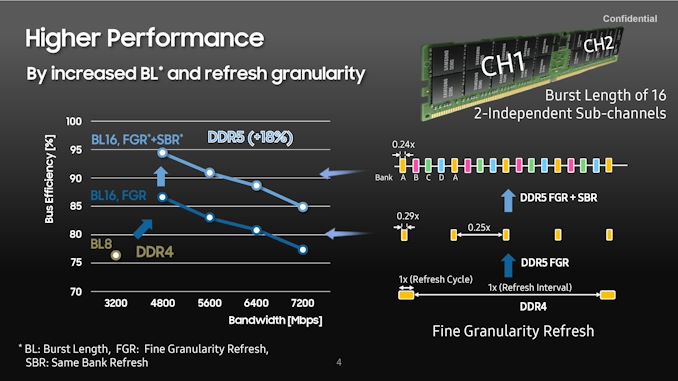

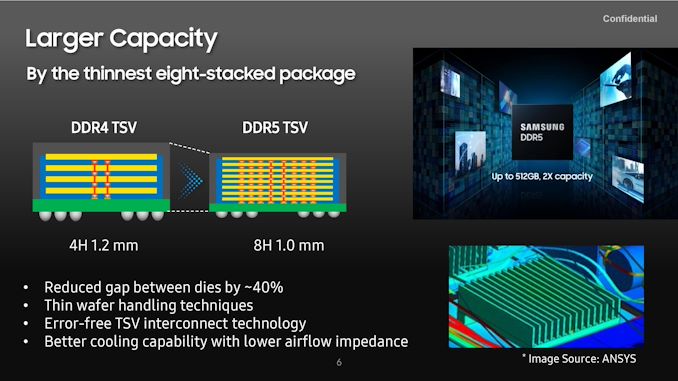
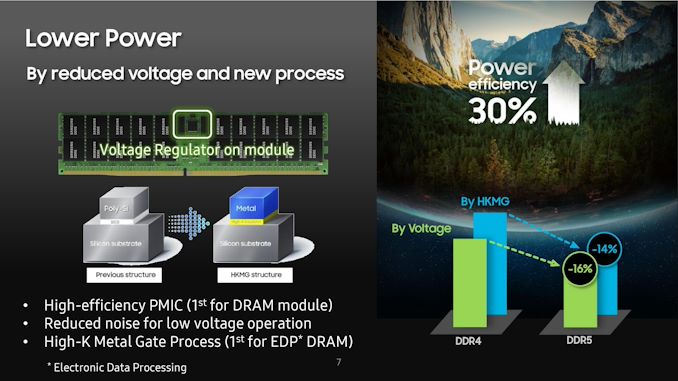









27 Comments
View All Comments
TheinsanegamerN - Tuesday, August 24, 2021 - link
Everyone said the same thing about DDR4, and ddr3, and ddr2, and even the original DDR. Just chill bud. It'll get fixed withina year or so.Spunjji - Tuesday, August 24, 2021 - link
"And they did the minimum that they can get away with"10^-6 isn't "the minimum", it''s a massive improvement.
calc76 - Monday, August 23, 2021 - link
DDR5 UDIMMs are supposed to eventually scale up to 128 GB, not just 64 GB, as noted on AnandTech's article from Jul 14, 2020.back2future - Monday, August 23, 2021 - link
missing interaction between kernel and memory for sorting (by (AI) algorithm) for low and high demanded memory pages into lowest and low latency circuits (combining DDR4 and DDR5? worth effort?) and maybe freeing oldest memory pages if else OOM would be happen to be triggered?Oxford Guy - Monday, August 23, 2021 - link
Typo?‘Samsung states that the introduction of Same-Bank refresh (SBR) into its DDR5 will increase the efficiency of the DRAM bus connectivity by almost 10%, with DDR4-4800 showing the best efficiency in terms of energy from bit.’
I assume you meant DDR5-4800.
Athlex - Monday, September 13, 2021 - link
That's pretty much exactly what we had back in the bad old days of PC133 and DDR1 TSOP DIMMs. Memory sockets mounted at 45 degree angles to deal with the Z-height.pogsnet - Wednesday, September 22, 2021 - link
Meanwhile, VPS hosting services still offer 1GB plan or lower which is no longer good on today's use.